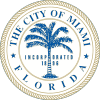Little Haiti
Little Haiti (La Petite Haïti) is a neighborhood in Miami, Florida. In the early 1900s, a small farming community, Lemon City, developed in this area, but it was a city only in name. The area had many lemon groves from where the town took its name. The town even had its own railway depot on the Florida East Coast Railroad. The growing city of Miami to the south, however, was looking for more property to add to their town. In 1925, Lemon City was annexed by Miami, along with the town of Little River to the north, and the town of Buena Vista to the south.

Through the years, the community has changed from agricultural to residential, from middle class to lower class and middle class again. Part of this change was driven by immigrants from Haiti, and soon the area was called "Little Haiti, (La Petite Haiti)." To a large extent, the Haitian Creole and Francophone culture thrives there, but because of discrimination and misunderstanding, certain practices like voodoo must be done in secret. Attempts are underway to make Little Haiti into an ethnic enclave, but this has been hampered by the fact that many prosperous residents have moved away. In the 1980s and 1990s, Little Haiti was one of the poorest areas in Miami and was known for its crime and drug trade. Some of this still exists today, however the area is experiencing a cultural renaissance.
In spite of the crime rate (which has decreased), the area of Little Haiti is currently experiencing a renaissance and a boom, due to the close proximity of the Design District and the development of the new nearby Edgewater community, where construction of multimillion-dollar high rises, night clubs, entertainment, and cultural centers are well under way, effecting increases in property value. As real estate prices continue to rise, Haitians and other residents of the low-income area are being displaced in a classic example of gentrification. However, "La Petite Haiti" continues its fight as a cultural heart for the Haitian Diaspora, as demonstrated by the recent inauguration of a large, beautiful statue of the father of Haitian independence; The General Toussaint L'Ouverture. La Petite Haiti also has a distinct Caribbean-Francophone flavor that hopefully will not disappear with the area's transitioning nature. Little Haiti is home of the Edison Courts housing developments and Miami Edison Senior High School. The area boasts various excellent art shops.
Little Haiti's boundaries are roughly as follows: to the north, 85th Street, to the west, Miami Avenue, to the east, Biscayne Boulevard (U.S. Route 1), and to the south, Northeast 36th Street (US 27).
The southern extremity of Little Haiti is now referred to as the Miami Design District, an 18 block section of art galleries, showrooms and restaurants located between NE 41st Street and NE 36th Street, Miami Avenue and Biscayne Boulevard.



